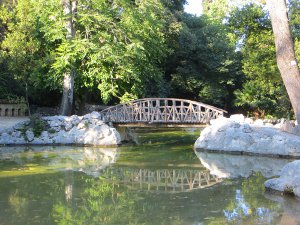Sights and Activities
Below are the places we saw and activities completed while visiting Greece:
Kastellorizo
Due to a cancelled ferry, we had a great opportunity to enjoy this island for a day. We walked around its main harbor admiring the colorful houses and took a short hike up to its castle, where the island gets its name from, to catch the beautiful views of the surroundings. The peaceful, non-touristy setting made this island one of our favorites from the ones we visited in Greece.

Rhodes
Odos Ippoton: or Avenue of the Knights is a cobbled stone street full of medieval buildings that gives you the feeling of stepping back in time.
Palace of the Grand Masters: this palace located on Odos Ippoton, is the most impressive building on the street and was restored, but never used, as a holiday home for Mussolini. The complex is now a museum with a collection of medieval artefacts.
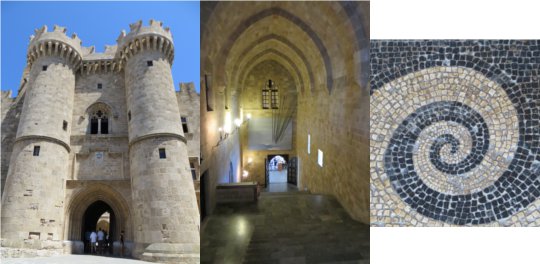
Rhodes Town: we spent all of our time on the northern tip of the island, where the capital is located. Within the capital, most of the time we roamed around the World Heritage-listed Old Town, the largest inhabited medieval town in Europe and a fine example of medieval fortification with its massive walls enclosing it.
Santorini
The island boasts astounding sights of the submerged caldera almost encircled by sheer lava-layered cliffs and topped by cliff top towns with white buildings that look like a dusting of icing sugar. But the island’s beauty has not come easy, a violent volcanic past is visible everywhere and through the centuries eruptions have regularly changed the shape of the island. First inhabited around 3000 BC, the island was circular and known as Strongili (Round One). About 1650 BC a massive volcanic explosion, which is speculated to be the biggest such explosion in recorded history, caused the center of the island to sink, producing a caldera that the sea quickly filled in. The lastest incident was in 1956, when an earthquake measuring 7.8 on the Richter scale killed scores of people and destroyed most of the houses in Fira and Oia. Our time on the island was enjoyed in Fira, the main town, which was full of infinity pools that perch on top of the caldera with stunning views. We also took a four hike to the village of Oia to enjoy a picture perfect sunset. Our visit to the island was complete with a nice wine tasting at the Domaine Sigalas Winery.

Mykonos
Getting lost in the snaking streets with white buildings and balconies filled with flowers in Hora (Mykonos Town) was our favorite thing to do on this island. The area known as Little Venice, where the sea laps up to the edge of restaurants and bars, and the hilltop row of windmills are as picturesque as you can get on the island. We also spent some time relaxing on the Paraga Beach where our campground located.
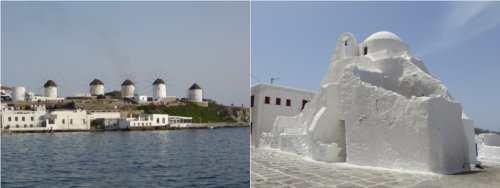
Athens
Lykavittos Hill: went up at night on a funicular train to the highest of the eight hills dotting Athens to enjoy spectacular views of the city, including the well-lit Acropolis.
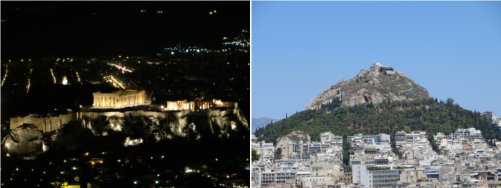
Roman Agora: the Romans built their agora just east of the ancient Athenian Agora and the few remains can be seen including the Tower of the Winds, built in the 1st century BC.

Ancient Agora: the location of the marketplace of early Athens and the focal point of civic and social life. The main monuments are the well-preserved including the Temple of Hephaestus and the reconstructed Stoa of Attalos, which houses the site’s museum.

Acropolis: we were at awe strolling through this complex that is arguably the most important ancient monument in the Western world: the Parthenon, completed in 438 BC, represents the glory of ancient Greece; the Erechtheion and Caryatids, the six maidens who support its southern portico; the Theater of Dionysos, which was built between 340 BC and 330 BC held 17,000 people; and the Theater of Herodes Atticus, which was built in Roman times and still used for performances today.
Acropolis Museum: contained all the findings of the Acropolis and the last level magnificently reflect the findings of the Parthenon.
Hadrian’s Arch: the arch has been proposed that it was built to celebrate the arrival of the Roman Emperor Hadrian and to honor him for his many benefactions to the city.
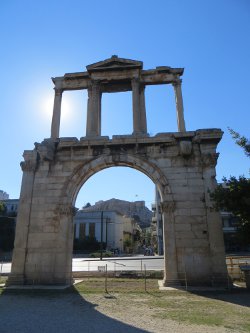
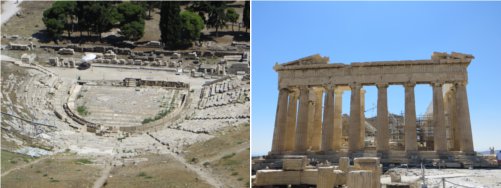
Temple of Olympian Zeus: Greece’s largest temple is impressive for the sheer size of its Corinthian columns. It took more than 700 years to build.
Panathenaic Stadium: built in the 4th century BC as a venue for the Panathenaic athletic contests and hosted the first modern Olympic Games in 1896.
National Gardens: we took a short walk through the delightful, shady refuge.

